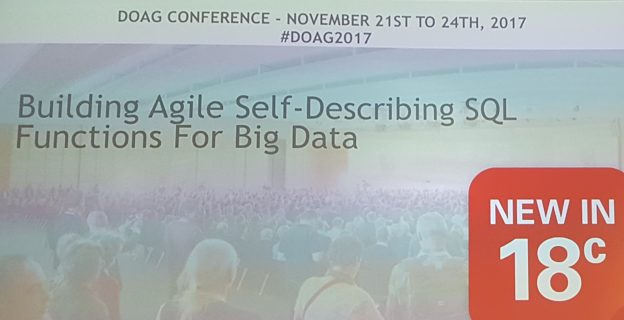Online Statistics Gathering has been introduced in 12c and is a very handy feature for ETL and batch jobs developers. However the devil is in the detail. There are some points to remember. Let’s take a closer look. Continue reading
Author Archives: admin
Conditional Logic in SQL
A few days ago Sven Weller has published an excellent post about writing conditional logic in SQL and it reminded me of an example I used in one of my presentations. It is also about conditional logic in SQL but maybe some less obvious use cases in context of function calls and sorting. Continue reading
Polymorphic Table Functions Example – (NOT) Transposing Rows to Columns
It was not possible for me to write a follow-up to my last post about Transposing Columns To Rows with PTF showing an opposite task of transposing rows to columns right next weekend as I thought. Partly because of our awesome Trivadis TechEvent which took place back then and partly because this kind of the exercise turned out to be much more difficult one as supposed. Actually it is a nice example to see the limitations of the new feature. Continue reading
Polymorphic Table Functions Example – Transposing Columns To Rows
Hey, Oracle 18c is now available on the cloud and for engineered systems! For more than a week now. That also means you can play with it at LiveSQL. And of course you can try polymorphic table functions (PTF)! At least I’ve done that this weekend 😉 And here is my first working example. Continue reading

Polymorphic Table Functions
Last month I attended the DOAG conference in Nuremberg. As always, it was a great event, awesome community and excellent tech talks. And it seems that I’ve found what could be my favorite feature in the upcoming database release 18c. Keith Laker (@ASQLBarista), Oracle’s Product Manager for Analytic SQL, talked about “Building Agile Self-Describing SQL Functions For Big Data”. This title was promising enough for me and of course I wasn’t disappointed. Thanks a lot for an interesting presentation!
This blog post will be somewhat unusual, because I have actually no knowledge to share yet, but only the euphoria about the power and flexibility of the new feature. So what is it about?
Continue readingILM – is it possible to mix ADO policies for compression and storage?
Never thought I would write much about Information Lifecycle Management, as I am actually a developer and not a DBA. I think, it is indeed a topic mostly relevant for DBA’s. But it is generally a good thing, if developers and DBA’s have a deep understanding of each others job, isn’t it? We are giving an overview of the ILM features in our training “12c New Features for Developers” and I’m one of the course instructors for it. That’s the reason, why I’m writing meanwhile the third post about it. Just to clarify some questions, which are not so obviously documented.
After looking at ADO conditions for storage tiering policies and using user defined PL/SQL conditions in previous posts, I was curious whether it is possible to mix storage and compression policies for the same segment? Wouldn’t it for example make sense to move the segment to a low cost tablespace and compress the data within the same action as well? I’ve sometimes heard the opposite statement. But it is very simple to test it, not just trust it. Let’s try it. Continue reading
Custom ILM ADO policy conditions using PL/SQL
In my previous post about ILM storage tiering I wrote about ADO conditions that we can provide for storage tiering policies if moving the segments to a read only tablespace. Another option to make storage tiering “conditional” is to provide a custom condition as pl/sql function returning a boolean. How does it work? Can we use Heat Map information? Continue reading
ILM storage tiering
Being not really new term introduced in 12c, Information Lifecycle Management has been enriched with two new features: Heat Map and ADO (Automatic Data Optimization). The letter allows to define policies on data segments (tables, partitions), which consist of conditions and actions. The conditions are generally being checked based on the information gathered with the Heat Map and defined actions are then taken: compress the data (compression tiering) or move the data (storage tiering). I said “generally”, because, on the one hand, one can define custom conditions (PL/SQL functions) not necessarily using Heat Map and, on the other hand, because of the rather confusing situation using conditions with storage tiering. Continue reading
Debugging SCD2
This post is again about the Slowly Changing Dimensions Type 2, but focusing on another problem. Once you have a need to validate the versioning mechanism, how you can do this? Or, in other words, having several versions of the same data (identified by the natural key), how to check what fields have been changed from version to version? Working with systems like Siebel CRM, which have some tables with 500+ columns, this possibility was really useful.
Of course you can write some PL/SQL code and iterate through the columns to compare their values. But I’m a friend of “pure SQL” solutions – let’s see how this can be done. Continue reading
Data Historization II
In the previous post I have shown how to use a combination of a UNION ALL and a GROUP BY to do a slowly changing dimension type 2 data historization. I’ve done some tests since then to compare performance of this approach with common methods in various situations. Continue reading
